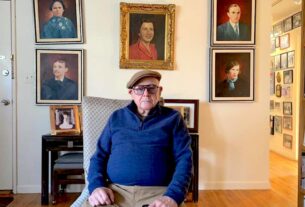((JR)) — More than 50 years after she became the first woman to be ordained by an American rabbinical seminary, Rabbi Sally Priesand has set another precedent: Beginning later this year, she will be the first woman rabbi to be featured at the Smithsonian National Portrait Gallery.
But Priesand will not be the gallery’s only Reform rabbi: Another exhibit recently began displaying a portrait of Rabbi Isaac Mayer Wise, the 19th-century rabbi who founded the seminary that, nearly 100 years later, would go on to ordain Priesand.
The portrait of Priesand, who was ordained by the Reform movement’s Hebrew Union College in 1972 and retired from a New Jersey pulpit in 2006, will be shown beginning in October as part of a 21-work collection titled “Recent Acquisitions” that largely features portraits by or of women.
The work is an inkjet print of a 2022 photograph by Joan Roth, who is known for her photographs of Jewish women around the world. It depicts a smiling Priesand wearing a multicolored prayer shawl and holding a Torah scroll whose cover displays the word “avodah,” Hebrew for “worship” or “service.” Roth drew inspiration from a photograph taken fifty years earlier at Priesand’s ordination.
Priesand’s photo will hang beside those of other pioneering women, including pop star Beyoncé, science fiction author Octavia Butler, Hollywood icon Greta Garbo and Ruth Bader Ginsburg, the late Jewish Supreme Court justice whose likeness has previously been featured elsewhere in the museum. The exhibition will run until November 2024.
Wise’s portrait is an oil painting on canvas, and has been in the possession of the National Portrait Gallery since 1977. But it was undergoing conservation work until recently and has never been shown on the museum’s walls. Painted by artist Morris Goldstein in 1881, it shows Wise sitting in an armchair with his elbow resting on a stack of books. Folded underneath the books is a copy of The American Israelite, the newspaper he founded in Cincinnati in 1854 that is the country’s oldest running Jewish publication.
Wise’s portrait is now on display as part of the museum’s “Out of Many: Portraits from 1600 to 1900” exhibition, whose works are switched out periodically. It hangs in a room that also includes a bust of turn-of-the-20th-century African-American educator and author Booker T. Washington and a photograph of Sarah Winnemucca, birth name Thoc-me-tony, a 19th-century advocate for Native American rights.
Wise was also a pioneer in the Reform movement, allowing mixed-gender services and replacing bar mitzvah rituals with confirmation ceremonies, among other changes. He founded Hebrew Union College in 1875.
Both the conservation of the Wise portrait and the creation of the Priesand portrait were funded by Reform Rabbi Amy Perlin and her husband, former World Bank and Capital One CFO Gary Perlin. Rabbi Perlin is the first female rabbi in the United States to start her own congregation, Temple B’nai Shalom in Fairfax Station, Virginia.
In addition to Wise and Priesand, the museum has portraits of early 20th-century Reform Rabbi Judah Magnes; 19th-century Dutch-American Rabbi Samuel Myer Isaacs; and 20th-century Reform Rabbi Stephen Samuel Wise. None of those works are currently being displayed at the museum.




